
..........................................................................................................................................................................................................
the answer is blowing in the wind
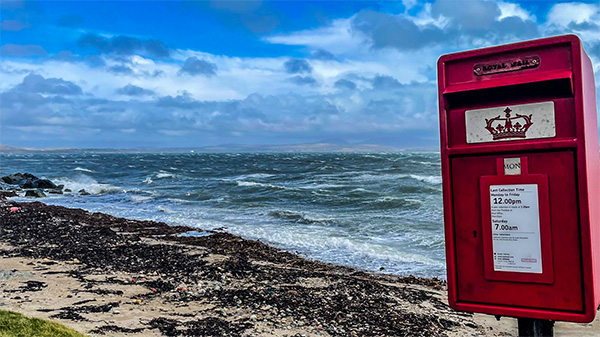
though i realise i am at risk of being one of those individuals accused of having doth protested too much, i really have little interest in any specific form of training, a point i have reiterated so often, it has probably entered the realm of cliché. i am well past the point at which i could make any inroads to the outcome of competitive events; even attempting so to do, would undermine the facts that, for starters, i have no competitive gene about my person, and no great desire to involve myself in an event where i am likely to come off worst. i already own more than one black jersey.
however, even on days when all i, or my sunday morning colleagues, have in mind, is a relaxed perambulation of the estates, the effort required to do so can be considerably more onerous than my simplistic framing of the situation would suggest. of course, that's hardly a state of affairs that will impinge upon the hebrides alone, but misplaced faith in weather forecasts can play havoc with anyone's intentions.
i have lived in the hebrides for well over 30 years, during which time i figure i must have witnessed pretty much every possible variation in the weather, even as far as witnessing small tornadoes, hurricane force winds, snow, torrential rain and a litany of storms bearing the now fashionable, alphabetically listed names. perhaps i would find myself better prepared if i had done the same as one of my former neigbours, a fellow who sadly passed away a few years ago. all but obsessed by the weather (very easy to do around these here parts), he had kept a daily diary for several decades detailing the weather, wind direction, amount of precipitation etc., etc.
and despite many contending that weather systems have become less stable of late, leading to stronger and more frequent winds, accompanied by a greater depth of annual rainfall, according to his diary, islay's weather had scarcely varied over the years. yes, some years featured more frequent storms, some years had seen no snow, and others had seen a diminution of rainfall, but averaged over time, there was no remarkable difference. extrapolated across the country, that would perhaps suggest that it is our greater obsession with the weather that has led to a possible exaggeration.
but the worst aspect of this, from a personal point of view, is an apparent lack of being able to read the weather any better than i could thirty years ago. even on last friday afternoon, as my ride colleague and i cycled to debbie's for an afternoon coffee, i was sure we'd be experiencing a troubling headwind on the outward journey, yet the opposite turned out to be the case. and congratulating myself on not having over-dressed for precipitation, you can only imagine my disappointment when a curtain of rain hammered on the cafe windows as we supped a welcome cup of froth.
however, i digress, for originally we were discussing my much-vaunted aversion to training. at least two of the sunday peloton are happy to identify as zwifties, confining many of their training sessions to two-up group rides across the highways and byways of watopia on internally stationed wattbikes. and it seems that their many indoor sessions may have worked in their favour; despite my spurious disparagement of such methods, i cannot deny that i am often left trailing in their wake, particularly when the road heads upwards. in mitigation, however, they are at least some fifteen years younger than yours truly, which must have at least some bearing on the situation.
yet, it's a situation with which i am content, feeling little in the way of a need to up my game to keep their rear tyres a little closer to my front. and then i experience one of those sunday mornings that forces the result in spite of myself. panting half-heard tautological statements like "you sure as heck don't get this on zwift", two of us slogged into headwinds and crosswinds well in excess of their forecast strength, with even a few scary moments when it felt as if rider and bicycle were about to be unceremoniously dumped on the roadside verge. you would scarcely have believed the angles at which we rode up uiskentuie strand, angles which would have ensured us falling over, were it not for heavy crosswinds that effectively prevented that happening.
gravity defying.
the upshot of it all is that, out of necessity, i had to reach deep into my suitcase of pain, as a tour de france commentator would undoubtedly have said, simply to make it as far as bridgend village. it's a ride that could normally be concluded in considerably less than thirty minutes, but yesterday was nearer forty minutes. the fact that i struggled to walk upstairs for a shower and subsequently had little desire to arise from the armachair, would tend to suggest that i may have stretched my no training rule just a smidgeon past breaking point.
it was purgatory at the time, but now written down, i have attempted to show it as possibly heroic. and i'm even more convinced that training is certainly not for me.
photo: joe marshall
monday 14 march 2022
 ..........................................................................................................................................................................................................
..........................................................................................................................................................................................................endura mt500 burner clipless offroad shoes

though it often appears as a disconnected oddity, the guardian newspaper has a history of featurng almost all of the international fashion shows. i say disconnected, because the reports and photos always seem to be placed adjacent to what might be termed 'more serious' news. though i have watched the meryl streep movie the devil wears prada, i still cannot fathom what the outfits seen on the catwalk have to do with real life.
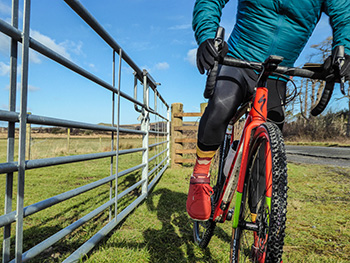
personally, i've never been a follower of fashion, and i'm pretty sure that mrs washingmachinepost would never describe me as fashionable' in any sense of that word. that's not to say, however, that i have not been seen in the very latest cycling kit, very much at the behest of the world's top cycle clothing purveyors. this occasional state of affairs can only be described as accidental. yet i think it's fair to say that cycling fashion comes from a different place than does gucci, prada and versace.
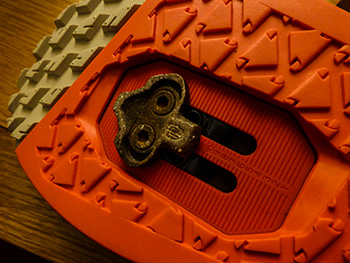
a substantial portion of contemporary cycle fashion emanates from both a need and desire to be seen. and while much of it seems perfectly at home on the bicycle, i'm not sure that the public response would be quite so accepting if it were worn to walk down bowmore main street on a saturday afternoon. perhaps i might cite as an example, the brightly coloured endura mt500 footwear which has graced my feet recently. it's not often that a pair of shoes perfectly complement a fluorescent and lime green cyclocross bicycle, but for once, these are a perfect match.

yet, when worn in debbie's for the requisite double-egg roll and soya latte, not one person on the premises made even passing mention. i'm almost certain that, had they been worn with a pair of jeans and a sweatshirt, eybrows would have been raised. these are the very shoes i'd wear in the event of having to ditch in the sea, to ensure the helicopter would find me first.
but the colour (cocoa) is not the only brilliant thing about these shoes.

before road racing became the predominant obsession of the cognoscenti, there was mountain biking, clothing for which scotland's endura were rightly renowned. yet throughout the 1990s, when the arrowed logo could be seen in a wide variety of offroad locations, they never made it as far as your feet (socks notwithstanding). this situation has been recently remedied with the release of three different styles of offroad shoe: the mt500 burner clipless shoe, an mt500 flat shoe, and last but not least, the humvee flat pedal shoe. while several of the sunday peloton opt for spd compatible footwear at all times, as a traditional luddite, i'm more inclined to opt for the usual three-point cleated shoe, the ones that make you walk like a duck.
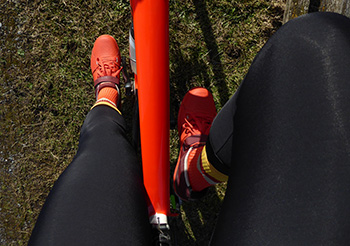
however, allied to the road-going genre, is cyclocross, perhaps even more so nowadays that the likes of wout van aert and mathieu van der poel have carved out successful careers in both disciplines. i am not a mountain biker by any stretch of the imagination (dude); there are no mountain bikes in the washingmachinepost bike shed. but there is a brightly coloured cyclocross bike, and personally, i can see little, if any, difference between the footwear required for either type of offroad excursion.

first off, the mt500 shoe is available in less ostantatious colours than the orange/red combination seen here, but all share the same features, including the ergonomistry tech developed in conjunction with physiotherapist, phil burt. the shoe looks very much like a contemporary training shoe, but features a thick, stiff sole, the cleat inserts of which are covered by a bolt-on mini-sole, that would allow them to be worn as regular footwear should you fancy doing so.

these are the very shoes about which i wrote recently, on which i placed the cleats in my usual fashion, as far forward as possible. slight calf-muscle discomfort enforced a re-appraisal of that choice, subsequently necessitating sliding the cleats a few millimetres rearward, a move that solved the problem instantly. the soles, according to endura, are designed to handle abuse, providing shock absorption along with reinforced toe and heel boxes. to test out the grip and abuse factor, i performed my wout van aert impersonation, by running up a gravel track while shouldering the bike. and, in what would obviously make for an excellent film title, that gravel track featured a river that runs through it.

but aside from a necessity to successfully clip into whichever brand of pedals are affixed to your bicycle, there's the comfort factor to be taken into account. the insole is, as mentioned earlier, ergonomically designed to offer the maximum level of support and comfort, a task that it achieves with aplomb. when first worn, it's possible to detect through the insole, just where those cleats are positioned, but after a kilometre or two, that sensation subsides and we're right back to comfort and joy.

laces seem to be the preferred fastening method for offroad shoes, as opposed to the boa-style closures featured on many road shoes. the mt500s arrive with two sets of laces: plain and stripey. the latter i saved for a later date. unlike other lace-up shoes in my possession, instead of a small elastic retainer midway along the tongue, to keep the laces away from thrashing chainrings, endura have solved the problem by means of a velcro strap on top of the shoe. this threads through a slot on one side of the shoe, allowing it to be tightened to the desired level. in practice, it works highly effectively.
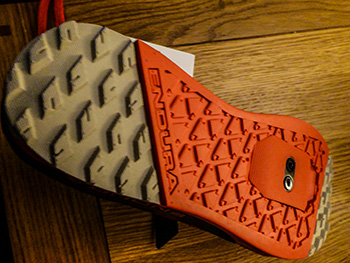
descriptions are all very well, but the proof of the pudding, to coin a phrase, is in the cycling. in this case over the course of a few hundred kilometres. aside from my inadvertent mis-positioning of the cleats on the first ride, the subsequent adjustment solved the discomfort engendered by the latter. of course, had i read endura's description: 'an off-set cleat box with increased longitudinal adjustment.', i could probably have sussed this out from the start. the shoes are commendably comfortable, with padding in all the right places to support my intrepid footwork.
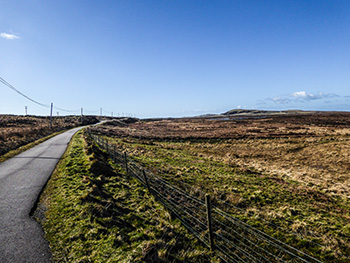
i've already mentioned my attempt to run up the middle of a rain-infested gravel path, but i also spent a few metres walking along what passes for an islay road, just to check my nifty footwork on grass and tarmac, in case the cleats were inclined to stifle forward movement. box successfully ticked. the shoes are well ventilated, lightweight and comfortable. it's possible that gonzo mountain bikers are a tad heavier on their footwear than yours truly, but the sturdy construction looked as if it could withstand extended periods of scrabbling amongst the undergrowth.
for their first venture into the footwear market, endura would appear to have hit the ground running (if you'll pardon the pun). this mt500 burner clipless version would suit both cyclocrossers and gravellists as well as the bouncy farm gate brigade, and probably work every bit as well south of the border as they do up here.
endura's mt500 burner clipless offroad shoes are available in sizes ranging from 38 - 47 and in black, cocoa (as reviewed, size 44), forest and navy. price is a very affordable £129.99.
sunday 13 march 2022
 ..........................................................................................................................................................................................................
..........................................................................................................................................................................................................yes we can
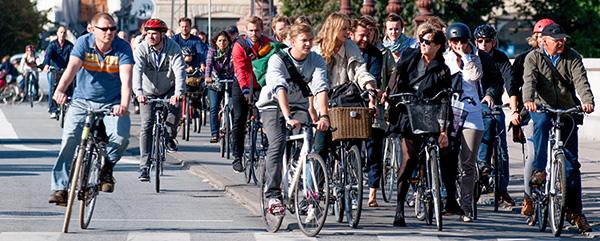
according to chris boardman, in his position as interim head of england's active travel, half of all journeys in england could be made by walking and cycling by 2030. i tend to think the same could be said for scotland, though due to the low population density in the highlands and islands and the greater distance between towns and villages is likely to mitigate against such a high figure. or is it?
every second friday afternoon, two members of the sunday peloton and yours truly take copies of the local newspaper to debbie's in bruichladdich and the village shop in port charlotte. the pedalling distance from bowmore to bruichladdich is just over 14km, with a further 4.5km to port charlotte. two of us usually stop off at debbie's for coffee, while the third member heads to the next village. that means for two of us, the return trip is a shade under 29km.
i appreciate that such a trip can be blissful in comparison to a similar journey through a city centre, where the scenery is likely a tad less delightful, but then on a day like yesterday, in 70kph winds and heavy rain on our return, it's a journey that may suit only the more intrepid amongst us. however, there's also a degree of necessity in our ministrations; while the fellow from port charlotte owns a motor car and therefore has made the choice to ride his bicycle, the two of us stopping at debbie's do not own cars. in fact, my friday afternoon, bruichladdich compatriot doesn't even drive. as it happens, he works at bruichladdich distillery and cycles the above mentioned distance every working day.
it is, i believe, naive to think that because we're happy to cycle these journeys, everyone else should do likewise. however, i also do wonder why it is that folks don't either walk or cycle comparatively short journeys, from home to work, to the shops or to school. the local secondary school has a perspex covered cycle rack to replace the previous one which blew away. but the only cycle you'll ever see within its confines, is that of the head teacher who lives perhaps one kilometre from the school.
i have no idea whether he needs to transport a laptop or paperwork to and from school, but whatever he needs to carry seems to fit within his backpack. however, there are several members of the teaching and admin staff who stay a darmed sight closer, yet they choose to drive. as i have mentioned previously, to the point of boredom, way too many individuals on islay (and, by implication, everywhere else) drive unbelievably short distances to work each day, probably the same individuals who currently moan at the increasing cost of petrol and diesel. so why does this happen? or more to the point, how did it become the norm?
i read a tweet during the past week that posited that petrol would have to reach $50 a gallon, before americans would consider walking or cycling anywhere. that seems a tad far fetched, but then again, perhaps not. in the uk, energy bills have more than doubled since november last year, food prices are on the increase, broadband is becoming more expensive and it would be a complete hermit who was unaware that the cost of living is verging on the unpalatable.
heating our homes is more or less a necessity, however high you like the temperature, while usage of electricity for heating water, showering, for cooking, for washingmachines, for fridges is all but non-negotiable. internet access, for the majority, is as much a necessity as is running water, and a family has to eat.
however, for a large number of individuals, use of a personal motor car is entirely optional. many central urban areas feature wall-to-wall public transport. i have long wondered why anyone drives in london, given the frequency and relatively low cost of the underground and bus network. and in small villages all across the highlands and islands of scotland, the distance from home to work can easily be covered on foot or on two wheels. for instance, bridgend village has very few inhabitants, so for those living in bowmore (5km south) who may find work at the hotel (when it re-opens) or the village shop, cycling, even after dark, would hardly be an onerous responsibility. but i could almost guarantee that none would consider that option.
plans are afoot (if you'll pardon the pun), to construct a mixed-use path between bowmore and islay house square in bridgend, eventually improving access for those on foot or two wheels. the three distilleries path extending from port ellen to ardbeg, passing laphroaig and lagavulin (and eventually farkin) is well used, predominantly by walkers. and similarly the recently opened, mixed-use path, between bruichladdich and port charlotte, proving, if nothing else, the value of the phrase 'build it and they will come'.
but such facilities only go part of the way to fulfilling the ideal of an increase in active travel. the second part is to change the mindset of those who not only would scarcely see walking or cycling as an option, but those who go to great lengths to explain why so doing is perfectly ideal for everyone else, but personally, unsuitable for them.
if the price of a barrel of oil continues to increase at its present rate, it may force more individuals to consider either walking or cycling, though it's sad to think that, like everything else in life, it all comes down to money. you can bet your bottom dollar that, for those who do adopt active travel as an alternative to paying high prices at the petrol pumps (and lets face it, with the substantial increase in energy prices, it's not going to be a lot cheaper to run an electric car), if and when the costs revert to more amenable levels, the car will probably, once again become top dog.
when i moved to the hebrides well over 30 years ago, when querying the apparent lack of anyone else cycling, the consistent reply cited the perennial high winds as the reason. however, even in my advancing years, i'm still able to ride through the majority of atlantic gales, whether they bear specific names or not. chris boardman has a target of 50% of all journeys made actively by 2030, the very year when all new cars will require to be powered by electricity. i think his rose-tinted glasses may be just a bit too optimistic (though i'm happy to be proved wrong).
suitable infrastructure is undoubtedly a major part of the equation, but at some point we have either to hope that the nation's mindset changes for the better (as seen from our point of view), or someone (mr boardman?) has to evolve a strategy to persuade the great-unwashed to adopt these much-needed changes. i confess i simply do not understand why so many people choose to drive as little as 100 metres, when walking would be so much more logical. but then, nor do i understand why large suvs are so popular. and i can't help agreeing with a colleague who said that even in these straightened times, petrol's obviously just not expensive enough.
saturday 12 march 2022
 ..........................................................................................................................................................................................................
..........................................................................................................................................................................................................trouble at t'mill
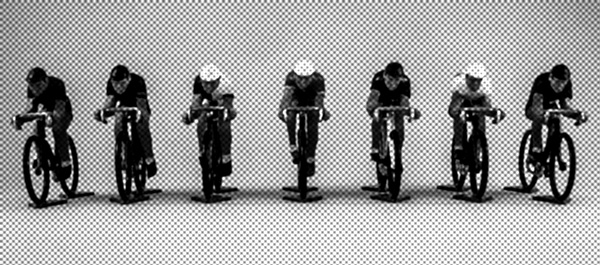
those who, like me, have been around cycling for more years than we're keen to admit, and possessed of an acute, yet slightly distorted point of view, can surely not have failed to notice a disturbance in the force over the last decade. there is an oft-quoted saying that contends there is nothing new under the sun, along with its partner 'what goes around, comes around'. or words to that effect. it's scarcely a phenomenon that solely afflicts the velocipedinal realm; only the other day, the sunday peloton (and aging group, if ever there was one) was discussing the naivety of today's youngsters in their praise for allegedly 'new' songs, that are, in fact, retreads from the 60s or 70s.
'there's nothing new under the sun'
max leonard's recent publication, 'further adventures in rough stuff' proves conclusively that riding the road less travelled did not begin with the advent of the mountain bike in the late 1970s, and certainly not at the behest of the current darling of the shop floor, the gravel bike. and though the e-bike has recently made rapid inroads into the psyche of the great unwashed, patents have existed for attachment of an electric motor to a bicycle since the late 19th century. since both the above have antecedents, one does wonder why they've chosen now to resurface, all the while pretending to be something new.
the rise and rise of the gravel bike may possibly be at the behest of increased traffic on many roads in the western world; an attempt to wrest back control of our own destiny, and avoid frequent altercations between cyclist and motorist. or it could just be a triumph of contemporary marketing. the e-bike, on the other hand seems to encourage the opposite state of affairs, bringing more adherents of the battery onto the road space made vacant by disappearing gravel riders. and, in our world of instant gratification, the e-bike surely promises an active life of sorts, without the need to inject too much in the way of effort.
and just don't get me started on the zwifties, a whole subset of velocipedinists who seemingly harbour a fear of the great outdoors and anything that might constitute a less than billiard-table flat road surface in wet weather. all the above could be portrayed as reasonable explanations, but i believe it's a lack of faith that has created these three scenarios in the face of encroaching reality.
at one point in time, not so very long ago, the world of the road rider was ostensibly conditioned by the existence of velominati's rules. the keepers of the cog amassed a total of 95 rules to which an unwritten adherence was implied, if not specifically demanded. the favoured numbers were #5 (harden the f**k up), #9 (if you're out riding in bad weather, you are badass, period.) and #12 (the correct number of bikes to own is n+1). it has been pointed out that, with the emergence of both gravel and e-bikes, the latter rule has become a tad more onerous than it was at its inception.
the rules were originally published in book form in the summer of 2014, following a lengthy period of existence through word of mouth and in pixel form on the velominati website. there have been those who have publicly railed against these rules, convinced that cycling needed no rules; any necessary direction would have been imparted by the old fellows in the cycle club, and probably more forcefully than any website or book could achieve.
those who doth protest too much probably take everything in life too seriously, blissfully unaware that the rules, if anything, were advisory, and very much conceived with tongue firmly positioned in cheek (well, apart from rule #5, obviously). but such individuals notwithstanding, it has been the failing influence of the rules over the past eight years that has brought plague and pestilence upon our world. had the keepers of the cog continued to exert an even-handed influence upon us all, the gravel bike would still be an object of derision, anyone who even suggested road-testing an e-bike would have been shunned by polite society, and indoor riders on zwift would have been rightly banned from ever owning a bicycle ever again.
keep the faith.
friday 11 march 2022
 ..........................................................................................................................................................................................................
..........................................................................................................................................................................................................alternative solutions
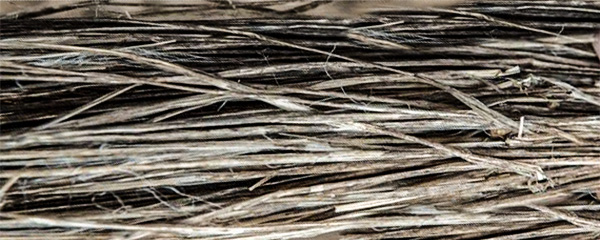
around 20 years ago, i bought myself my very first carbon-fibre bicycle, a colnago c40 hp, with cantilevered chainstays that were almost 100% gimmick, attached to a b-stay at the seat tube. i figured i'd been a smartie in so doing, for aside from the bragging rights that came with ownership of one of the sport's iconic bicycles (i a still have an art decor version of the original c40), carbon fibre is essentially 'burnt plastic' (as described by mike burrows), a material well-respected for its non-ferrous properties. in other words, it doesn't rust.
i had possessed several steel-framed mountain bikes and road bikes prior to my c40, ridden in the perennial airborne salt spray off the north atlantic ocean. the pervasion of sea-salt in the galeforce winds has a strong propensity to rust any steel in its path, particularly componentry layered in chrome. so the option to purchase a frame made from carbon fibre seemed like the ideal means of avoiding degradation by ferrous oxide. and, to a certain extent, that proved to be true.
what i hadn't banked on, however, was the use of aluminium dropouts on front and rear forks, and threaded inserts into which certain items of componentry might be affixed. as it is, on the colnago c40 that i still own, the square-taper bottom bracket is pretty much stuck in situ. i am simply fortunate that it continues to operate as well as it did when new. and the rear brake caliper has also proved to be resistant to removal.
however, the ignominy that ultimately led to my having to dispense with the services of the c40hp, were the rear dropouts. these were fashioned from aluminium which corrodes by turning to white powder, via aluminium flakes. added to this, aluminium expands when it corrodes, initially experienced as a reluctance of the cassette to freewheel due to binding on the drive-side dropout. despite cleaning all this off with a copper bristled brush, to take it back to solid aluminium, and subsequently painting with a metal varnish, the dropouts continued to corrode. and while this may have provided a stay of execution, the problems persisted.
those aluminium dropouts became part of the frameset via extended sections that plugged into both chain and seatsays. when they too corroded, they also expanded, forcibly cracking the carbon fibre into which they slotted, eventually making the frame a danger to life and limb. suddenly the knowledge that carbon fibre doesn't corrode had distinct limitations, leading to the need for a replacement bicycle. i'm happy to say that the replacements have been constructed from steel, neither of which features even a smidgeon of chrome.
however, it transpires that, while carbon fibre may be the pride and joy of many a modern-day roadie, particularly now that carbon-fibre dropouts have become far more common, it's not a material that can be easily recycled, or recycled at all. nor, indeed, are its environmental credentials squeaky clean. because carbon fibres are fixed within a heat and pressure-cured resin, it's well nigh impossible to melt them down, often requiring chemical dissolution. apparently a lot of disposed carbon fibre is stored in old mines.
that rather takes the shine off the clearcoat.
the german institutes of textiles and fiber research are currently looking at the use of bio-based fibres, sourced from plant material, or other non-fossil sources. one of the components currently showing promise is that of lignin, particularly since it exists as a by-product of paper production. if taken from that particular source, the subsequent material could benefit from a substantial reduction in energy use, and research continues into replacing the currently used toxic solvents, with water.
however, the carbon fibre produced by this method is of lower grade than that realised from fossil fuels, so it's unlikely to replace the current methods in the short term. but it's early days yet. there's not really a specific moral to this story, other than to say it would make environmental sense to ride your current carbon fibre frameset for as many years as possible. meanwhile there has also been research conducted into the viability of plant-based fibreglass, successfully producing a look compatible clipless pedal.
flax has also proved suitable, a fibre at one time used in museeuw framesets and also realised as a folding bicycle frame constructed with woven linseed. flax is already used in motorsports and has the added benefit of being bio-degradable. just as long as no-one starts fitting aluminium dropouts.
thursday 10 march 2022
 ..........................................................................................................................................................................................................
..........................................................................................................................................................................................................god is dead. the rise and fall of frank vandenbroucke. andy mcgrath. bantam press hardback. 320pp illus. £18.99

i have never been one to possess the competitive gene as it relates to moments of sporting endeavour. the secondary school which i attended, in common with many, held an annual sports day, but due to the limited space on the sports field and the number of pupils, it was necessary to pre-qualify for participation. those excluded from taking part, were expected to form a well-behaved group of spectators, rather than bunk off down main street, which is pretty much what the athletically challenged did.
i'm sure you can see what's coming, but in order to prepare the way for bunking off, it was necessary to choose events in which one hadn't a chance of succeeding. in the case of yours truly, those were shot-putt, javelin and long-jump, none of which i came close to qualifying for. true sportspersons are, by their very nature, a competitive lot, usually accompanied by a huge dollop of natural talent, another factor entirely missing from my portfolio. belgian cycling wunderkind, frank vandenbroucke ticked both boxes.
former editor of rouleur magazine, andy mcgrath has written a stunning biography of this troubled individual, remedying the absence of a story that needed to be written for all manner of reasons, not least of which is to illustrate the differences between 'them' and 'us'. not entirely unlike marco pantani, vandenbroucke encountered a career that burned very brightly, but burned out all too quickly. frank vandenbroucke died in october 2009, aged only thirty-four.
belgium is probably the very best of places in which to be born if your future is to involve competitive cycling. from the legacy of the great eddy merckx, to iconic races such as de ronde van vlaanderen and liege-bastogne-liege and the country's reputation for breeding the archetypal 'hardman', it's hard to think of a european country that identifies quite so definitively with cycling. and then there's what is often regarded as the most identifiable of national jerseys.
though many would take exception to the book's title, the author has derived this from vandenbroucke's own biography 'Ik BenGod Niet' (i am not god). as it transpires, given the adoration foisted upon vdb during his career, this debatable moniker has justifiable credence. as if to underline the often confused aspirations of those 'blessed' with seemingly unbridled talent and ambition, like several other notable champions, vandenbroucke seemed both to deliberately attract such adoration, all the while finding it every bit as distasteful.
"At his first World Championships, for juniors, in 1991, he was the boldest, the ringleader seeking attention. Everything was a competition." compare this with a quote from much later in the book where journalist, jan antonissen states, "You always left with mixed feelings because you felt sometimes he had the sadness of a clown."
that natural talent surfaced even in advance of his chosen career as a professional cyclist. despite apparently owning a sprint akin to that of a slug, even against those older and more tactically experienced, aged sixteen, he rarely found himself off the podium. it's an interesting speculation as to whether talent is hereditary, but it served frank no ills in being the nephew of prologue specialist, jean luc vandenbroucke. his case was quite probably also advanced by his "immense humanity". as the author points out, "People were drawn to him and wanted him to do well."
vandenbroucke did indeed do well. in 1998 alone, he won paris-nice overall, the tour of wallonia, the tour of galicia, gent-wevelgem and took second place in fleche wallone, zuri-metzgete and kuurne-brussels-kuurne. the following year, he stood atop the podium at liege-bastogne-liege and omloop het volk, as well as winning the points jersey at the 1999 vuelta a espana. if ever there was a candle that burned brightly, vandenbroucke's was it.
but vandenbroucke's increasing volatility saw him changing teams almost every year. after a three year career with mapei, the following two years were spent with france's cofidis team. from 2001 to 2004, he rode for four different teams and ended his professional career in 2009 with the almost unknown 'cinell-down under'. the 1990s, however constituted a decade that professional cycling would probably prefer to forget, with epo raising its ugly head in 1994.
vandenbroucke's family was well-versed in the machinations of the sport. "...it's fair to wonder how clean Vandenbroucke was when he started out in the ranks of Lotto" (1994). according to the author, even at the age of sixteen, frank was "...not the type to miss a trick when it came to self-improvement." that may or may not have been the implication behind lotto team-mate's statement, "Frank just played with all of us, when it was uphill, he had such talent."
and it was arguably doping that eventually did for both vandenbroucke's professional and personal life. vandenbroucke claimed he started doping in 1996, claiming that, "...it would have been impossible to win without it." but, as pointedout by andy mcgrath, back in the nineties, team doctors were masters of their universes. frank was introduced to the sleeping drug, 'stilnoct' while at cofidis in 1999. take a massively talented individual like vandenbroucke and closet them in the distinctly odd world of professional cycle racing, where, by design, their every need is catered for, there's a distinct possibility of a collision of two strangely complementary worlds .
"The psychiatrist Jean-Christophe Seznec, who published a report on Cofidis's Stilnoct problem [...] states that some French riders compared the itinerant hotel-hopping life of bike races and training camps to being at a holiday resort with their family: it took away a sense of reality, so they let themselves go."
but the pervading individual behind a large portion of vdb's career was "A doughy, balding fifty-five-year-old man of average height with a podgy nose, clinical air and thin-rimmed glasses..." this was bernard sainz, a man renowned within french and belgian cycling. the great 'mabuse'. he became the guru behind the scenes, a man to whom vdb effectively handed over his physical and mental being, ultimately with less than agreeable results in the long-term.
frank's personal life was also one that started out with infatuation and a young family, but ended not only in divorce and a second marriage, but eventually in complete disarray. to be a champion athlete in any discipline usually entails inhabiting the outer edge of whatever it is the rest of us inhabit. add to that the previously mentioned iconoclastic lifestyle and introduce a bit of chemical dependency, and, in cases such as that of vandenbroucke, you have a recipe for disaster. it happens in rock'n'roll just as it happens in professional cycling. 'live fast, die young'.
andy mcgrath's research for 'god is dead' is little short of immense. he has not only interviewed many of those closely associated with vandenbroucke's career, but several less obvious in his frighteningly short life. and he appears to hold a compassionate empathy for his subject. the author does not, however, let the weight of the narrative obscure brief moments of literary sparkle. in describing vdb's personality, he incorporates an almost perfect example of alliteration: "Frank was a free-flowing fountain of feelings." later in the book, he exercises a mischievous sense of humour when reporting a misadventure during a holiday in guadaloupe, where vandenbroucke broke his collarbone: "Aside from his body parts, he couldn't seem to catch a break."
andy mcgrath won the william hill sports book of the year in 2017 for 'bird on the wire' a biography of tom simpson. it seems very likely that he might repeat the accolade in 2022. 320 pages of brilliance
'god is dead 'is published by bantam press on thursday 10 march.
wednesday 9 march 2022
 ..........................................................................................................................................................................................................
..........................................................................................................................................................................................................but what does that actually mean?

at one time, in the early days of computer advertising battles, it was all about megahertz. for every factor increase made by intel in processor speeds, the motorola powerpc, as employed by apple, would have to do likewise, and it ultimately became a matter of how many 'teraflops' could be accommodated in the race for supremacy. apple notably produced an advert trouncing intel, portraying one of the silver-suited intel bunnies trying to stamp out flames, having been apparently burned by motorola's recent speed increase.
these regular, expected increases in processing power very soon created a waiting culture; those who were in the market for a new computer, but reluctant to pull the trigger, safe in the knowledge that, as soon as their choice had been bought and delivered, a newer, faster machine would have been brought to market, rendering any potential bragging rights null and void.
however, what did those advertised increases in megahertz actually provide? if you were a gamer, film-editor, or photoshop guru, any increase in processor speed could offer perceived benefits, benefits to which i can readily attest when applying the more complex of photoshop's filters. however, for the majority of users, using their computers for word processing, web browsing and e-mails, the differences would be far harder to spot. let's face it; if the old model could achieve tasks in (for example), seven millisecnds, while the upgrade did the same in four milliseconds, could you really tell the difference?
and a faster computer wouldn't make a heck of a difference if your typing speed remained the same. so while those much-vaunted speed bumps were perfectly real, the real-world difference could often be considerably less apparent than the copywriters would have you believe.
i don't believe differences in processor speed comprise present day computer advertising. a bit like mobile phones being advertised on the advances made to their cameras, computers are often more likely to be distinguised by their design factors. it's likely that there is little to distinguish one from the other, apart from operating systems, and that's more down to individual choice, than any perceived advantage.
so how do all those copywriters occupy their time nowadays?
evidence would suggest that at least a few have transferred their allegiance to the velocipedinal realm. as evidence for my spurious contention, might i cite the example of a bicycle purveyor that shall, for the time being, remain nameless. according to persuasive words concerning their latest aero road frameset, there has been an overall increase in the stiffness of the bottom bracket by 13.35% and that of the head tube by 35.64%. i think it might be worth pointing out that the average bicycle head tube nowadays has to accommodate a 1.125" or 1.25" headset, meaning a very short tube with an optimised diameter. how many of you have noticed any flex in your headtube recently, or have the leg power to cause untoward movement in the bottom bracket shell?
do not misunderstand me; i am not contesting the manufacturer's quoted figures, but i am questioning their real-world relevance to the average cyclist. and it is pertinent that there is no attempt to relate those percentage improvements to anything that you and i might easily comprehend. if i were to tell you that this week's washingmachinepost was ten percent better than last week's, what would that actually tell you?
however, said manufacturer was not content to stop at that point. apparently, by situating the seatpost clamp in a lowered position, the '...increased cantilever action of the seatpost ..." increases its compliance by "...up to 8.5%." once again, does anyone, other than the company's engineers, really understand what that means? the aforesaid seat clamp, by offering two distinct positions offers two levels of compliance. without specific, numerical comparison, the word 'compliance' is a purely subjective term. one man's compliance is another man's lateral stiffness.
remember when we used to just go for a bike ride?
tuesday 8 march 2022
 ..........................................................................................................................................................................................................
..........................................................................................................................................................................................................